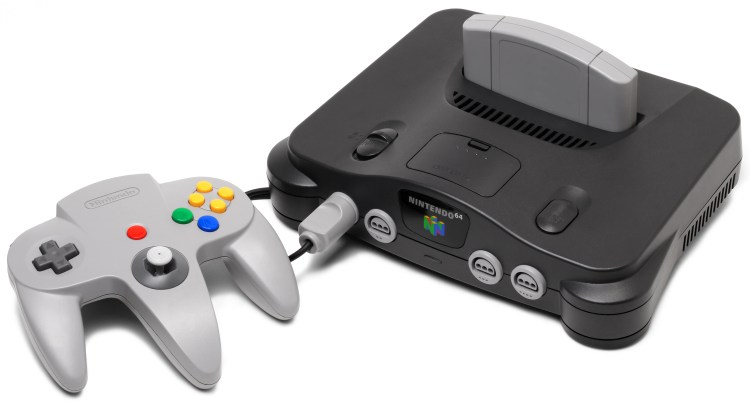This story originally published during the Nintendo 64’s 20th anniversary of its Japanese launch. September 26, 1996 was when it came out in the U.S., so we’re highlighting this piece to help celebrate.
Twenty years ago, 3D gaming (no, not the pop-out-at-you kind) was exciting. Thanks to a plumber, an ocarina, a British spy, and bear with a bird in his backpack, one home console was able to master this new age of gaming.
The Nintendo 64 debuted in Japan on June 23, 1996. That makes the console 20 years old. The Nintendo 64 pioneered 3D gaming, brought us some of the greatest hits of all time, and gave us some of the best multiplayer memories. It also marked the beginning of a lot the troubles that plague Nintendo to this day, specifically third-part issues and lower sales (the Nintendo 64 sold 33 million units).
Nintendo’s previous consoles were mostly based on 2D games. But the company emphasized the hardware’s 3D capabilities so much that even the system’s name reflected what it could do: it had 64-bit central procession unit (hence Nintendo 64). Its previous console, the Super Nintendo Entertainment system, was only 16-bit.
The games
The N64 made an impact on 3D gaming with its best launch game, Super Mario 64. Just like how Super Mario Bros. defined 2D platforming in 1985, Super Mario 64 became a blueprint for how to make 3D, third-person game. Mario could now run and jump around open spaces easily with the controller’s analog stick. Many fans and critics consider Super Mario 64 to be one of the best and most important games of all time.
But it wasn’t the N64’s only notable release. The Legend of Zelda: Ocarina of Time also brought that series to 3D. It’s still one of the best known entries in the franchise. It event created a template all 3D Zelda games followed for decades. Only the next entry, The Legend of Zelda: Breath of the Wild, seems to finally be ditching the Ocarina formula.
Meanwhile, GoldenEye made first-person shooters a hit on consoles, Star Fox 64 came with the Rumble Pack and introduced the control-shaking feature that’s now standard in all consoles, and Star Wars: Shadows of the Empire and Rogue Squadron gave aspiring X-wing pilots a chance to play out their fantasies away from a PC.
The Nintendo 64 also had four controller ports, while other consoles before and at the time only had two. This made the system fantastic for multiplayer games like Mario Kart 64, Mario Party, and Super Smash Bros., which started a fighting game franchise that would become one of Nintendo’s best-selling series.
The troubles
Despite all the great software and innovations, the Nintendo 64 was not the most successful system of its time. That honor belongs to the original PlayStation. Sony’s first console sold a whopping 105.5 million units. The Nintendo 64 only sold 33 million.
This was when Nintendo’s woes with third-party publishers really began impacting the House of Mario. For a long time, companies like Square, Capcom, EA, and Konami had to publish their games on Nintendo’s systems simply because it was the undisputed market leader, even if they were unhappy with Nintendo’s strict policies. At one point, Nintendo would even tell companies that they could only release five games a year. Nintendo was obsessed with controlling third-parties, and they resented it. Once Sega’s Genesis became popular in the early ’90s, publishers had another option.
Sega’s console in the Nintendo 64 era, the Saturn, was a bust and died quickly. Sony filled the void with the PlayStation — and companies unhappy with Nintendo’s policies still had another option.
That choice became easier when Nintendo revealed that the N64 would still use cartridges. By 1996, most consoles (including the PlayStation) were using CDs. Cartridges had less storage capacity and cost more to make, even if they could load games faster than discs. Cartridges were also harder to pirate. Still, most publishers prefered the lower cost and extra storage space available in CDs, especially once games began including videos and voice acting, both of which required a lot of memory.
Nintendo’s loss of third-party support would cost the system some big games, most notably with Final Fantasy VII, one of the PlayStation’s biggest hits. Before Final Fantasy VII, the series was exclusive to Nintendo consoles.
Despite the negatives, many gamers look back on the Nintendo 64 with fondness. Super Mario 64, Ocarina of Time, and others remain some of the best-loved titles ever, and no other system offered more fun for four friends with a big couch. Maybe Nintendo will try to recapture that spirit of technological innovation, discovery, and multiplayer fun with its next system, the NX.
VentureBeat's mission is to be a digital town square for technical decision-makers to gain knowledge about transformative enterprise technology and transact. Learn More



